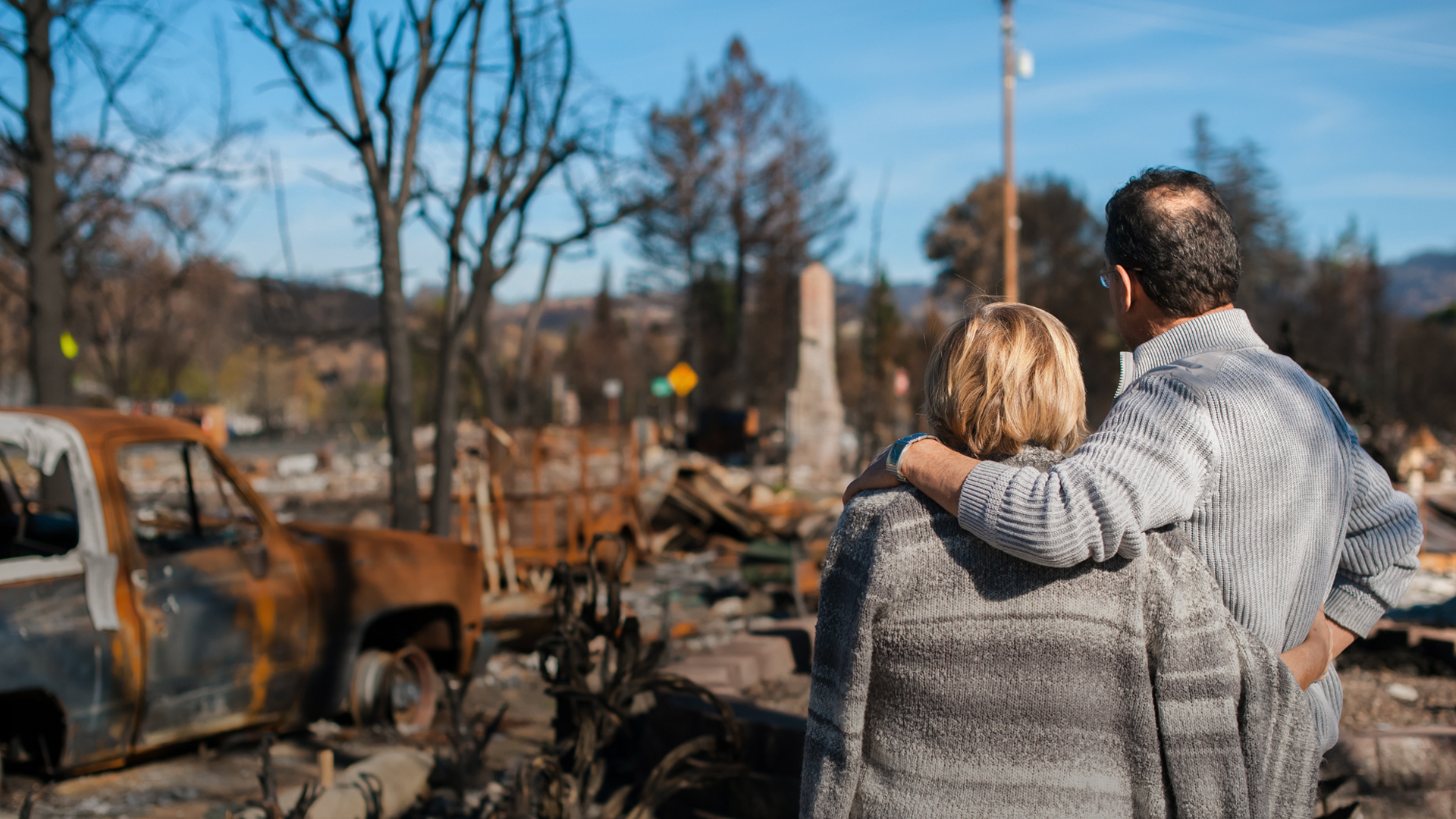More than a year and a half after the Marshall Fire decimated suburban Colorado in the dead of winter, P&C insurers worldwide continue to grapple with the new realities of wildfire risk. They’ll need a three-pronged approach to rethinking risk and response in the age of climate change.
As someone who started my career as a claims adjuster, I’ve seen firsthand the financial and emotional misery unleashed by catastrophes like the Marshall Fire. I know the pain behind the words of Louisville, CO, resident Nan Boultbee, who lost everything she owned when the blaze leveled her four-bedroom home.
“This is overwhelming for us,” she told the New York Times. “We don’t have a home to go home to.” She was also far from alone. Fueled by 110-mile-per-hour winds, the inferno incinerated 1,000 homes and businesses across 6,000 acres even as forecast snowfall threatened to freeze water pipes.
As the people of Maui, HI, recently learned, even lush tropical islands can be devoured by wildfire. In August, wildfires fanned by the winds of Hurricane Dora left scores dead or missing, sent tourists diving into the ocean to escape flames, and reduced the entire town of Lahaina to ashes. It ranks as the deadliest US wildfire in more than a century.
As Lt. Gov. Sylvia Luke told the Wall Street Journal, “We never expected a hurricane, which did not touch down on our land, would cause these kinds of wildfires.”
Such is the terrifying new world of wildfires in the age of climate change. According to the UN, the risk of catastrophic wildfires is expected to increase 14% by 2030—and as much as 30% by 2050—as rising temperatures intensify a “global wildfire crisis.”
But that may be the best-case scenario. Yes, total wildfire activity may have been down significantly during the first three months of 2023, thanks to this year’s record rainfall in the US West. But a protracted heat wave resulted in the hottest June in 174 years—and a jump in wildfire activity that put the nation’s first-half totals at 89% of the 10-year average, with 34,650 wildfires through August 16.
From April 1 through August 19, Canada had experienced 5,738 wildfires—the most in a single year—burning more than 33.9 million acres. At this writing, 1,000 wildfires are actively raging across Canada, with a state of emergency in the Northwest Territories and British Columbia prompting the entire city of Yellowknife and 15,000 residents of West Kelowna to be evacuated, with another 20,000 under an evacuation alert.
On a global basis, the unprecedented conditions fueling this year’s deadliest wildfires may not remain quite so “unprecedented” for long.
Fighting the Firestorm Ahead
As the Bulletin of Atomic Scientists recently pointed out, emissions from wildfires in recent years are accelerating climate change everywhere—creating a dangerous feedback loop that exacerbates wildfire risk on every continent. The record-breaking 2020 fire season in California, for instance, negated more than 18 years of carbon dioxide reductions—worsening the threat posed by wildfire worldwide.
As many may recall, deadly fires raged across 35 European countries during the summer of 2022, resulting in a 75% increase in land damage compared to the previous year. In Greece, the increase was 34%. In Bosnia-Herzegovina, it was 246%. Pro tip: When the words “Siberia” and “extreme wildfire seasons” are routinely used in the same sentence, all bets are off.
It remains to be seen what impact a moderate to strong El Niño weather pattern may have on wildfires this fall and winter. While El Niño formations typically bring more rain to Southern California, they often drive drier-than-average conditions in the Pacific Northwest. At this writing, above normal wildfire activity is expected to persist in the Pacific Northwest and elsewhere through October.
For insurers, it’s bad news all around. According to Swiss RE, natural disasters in all forms resulted in global economic losses of more than $120 billion during the first half of 2023—46% above the 10-year average. After averaging $600 million per year for most of the past two decades, insured losses have spiked in recent years. Insured losses from the Maui fire alone could exceed $3.2 billion. And California has suffered two roughly $10 billion-insured-loss wildfires every year since 2017. As the frequency and severity of wildfire claims continue to climb, insurers will want to revisit their game plans.
But fair warning: Adding exclusions and increasing premiums only go so far. And pulling back on issuing new policies in entire states due to high wildfire risk may not be a viable growth strategy—or even necessary. Instead, here are three ways insurers can harness technology to revolutionize how they write, mitigate, and respond to wildfire risk.
#1 Pricing Risk Right With Predictive Analytics
By now, most insurers recognize the need to run their operations on modern, cloud-based core systems that can turn vast amounts of internal and external data into a high-fidelity understanding of property risk. Traditional, territory-based models and past loss experience alone won’t cut it anymore.
Instead, historical data must be augmented with continuously updated intelligence that reflects the compounding impact of climate change as well as engineering and financial analysis from new catastrophic events. This is especially true when it comes to modeling wildfire risk, which is extremely data-intensive and must account for a wide variety of risk profiles within even the same neighborhood.
For this reason, a growing number of insurers are gravitating to analytics providers that combine machine learning and other AI technologies with geospatial data from a wide array of high-quality sources to provide accurate, up-to-date property risk scores via API.
When it comes to wildfires, solutions such as HazardHub go beyond non-predictive data elements like slope and aspect to factor rainfall and vegetation burn points into scoring. Proximity to fuel load is also key, since embers sent aloft can travel as far as 8,000 feet, endangering homes along the way.
Complementing this with data from sources such as Cape Analytics, Moody’s RMS analytics unit, and others can enable insurers to quickly understand not just a specific property’s unique exposure to wildfire risk, but also how much damage to expect.
Insurers armed with this level of predictive insight can go where less-competitive insurers increasingly fear to tread. Instead of bypassing whole neighborhoods or abandoning entire markets, they can spur growth by pricing risk accurately and profitably while surgically avoiding bad bets.
#2 Incentivizing Wildfire Mitigation Measures
Rewarding policyholders for taking steps to protect their properties from the ravages of wildfire isn’t just a good idea. In California, it’s also the law.
Under the state’s new Safer from Wildfires framework, insurers operating in California must now provide discounts to homeowners and businesses undertaking substantive wildfire mitigation efforts. These can include installing a fire-resistant roof or clearing vegetation.
The regulations, which went into effect on April 23, are the first of their kind in the US. But they could herald a wave of similar mandates elsewhere. So might the state’s stepped-up efforts so far this year to penalize insurers for overcharging for wildfire risk.
Insurers with platforms that connect to a well-sourced ecosystem that includes real-time and evolving data and solutions that leverage high-resolution aerial imagery, computer vision, and AI technologies will have a distinct advantage over those requiring on-site inspections. When integrated into the right platform, for instance, solutions from providers like Betterview, Maptycs, and others can be used to instantly verify and discount mitigation measures—achieving regulatory compliance while enhancing the customer experience.
And that’s just the start. Cities like Miami, FL, and Freetown, Sierra Leone, are appointing chief heat officers to take a proactive approach to global warming and wildfire prevention. And look for more initiatives like the expansive fire mitigation and resiliency efforts in Riba-Roja de Túria in Valencia, Spain. In California, even individual utilities like P&E are racing to put multi-billion-dollar capital-spending plans in place to cut wildfire risk. For its part, the entire state of Colorado is now moving aggressively to change the way it mitigates and responds to growing fire risk.
#3 Optimizing Proactive CAT Response
The ability to access actionable, real-time intelligence is critical to the triage and deployment of claims teams. In fact, modern technologies are transforming insurers from financial first responders into something far more profound during what can be a traumatic moment in their lives.
Today, Farmers Insurance and others are investing in next-gen drones and robots to quickly transmit images and intel back to claims offices—without sending adjusters into dangerous situations post-catastrophe. When tied to advanced claims systems, solutions like Matterport, HOVER, and PLNAR use augmented and virtual reality to enable claimants or field adjusters to report damages and settle claims quickly by simply uploading pictures of the damage, and providing details. 3D “digital twins” are then auto-generated, putting claims managers into the scene from their desktop or tablet computer (see the video below for more).
Leading-edge insurers are also leveraging new technologies to simplify and accelerate claims management through new forms of coverage like parametric insurance. Unlike traditional property coverage, a parametric policy might initiate payment to a farm when a wildfire exceeds a predetermined threshold, such as acres burned, rather than based on damage to physical assets. For insurers, it’s a cost-effective way to streamline CAT response by automating payments at the exact time when the volume of incoming claims might otherwise overwhelm capacity.
Burning Questions: No Longer Just ‘How’
According to Capgemini, only 35% of insurers have adopted technologies like the kinds I’ve described here. But as the threat posed by wildfire and other catastrophes continues to grow, those that do will have the competitive edge. The most agile will deliver the perfect blend of automation and the human touch to create truly differentiated service.
Those behind the innovation curve may want to speed up. Given the availability of vast amounts of data and the technology to leverage it, the industry will increasingly become part of a much larger conversation. As Capgemini suggests, questions will move from how best to ensure individuals and communities can rebuild post-inferno to if and where to do so.
Momentarily recalling my days as an adjuster and the grim toll wildfire can exact on people like those in the Marshall, Maui, and Canadian fires, one thing seems clear: An ounce of prevention has never been worth so many pounds of cure.



